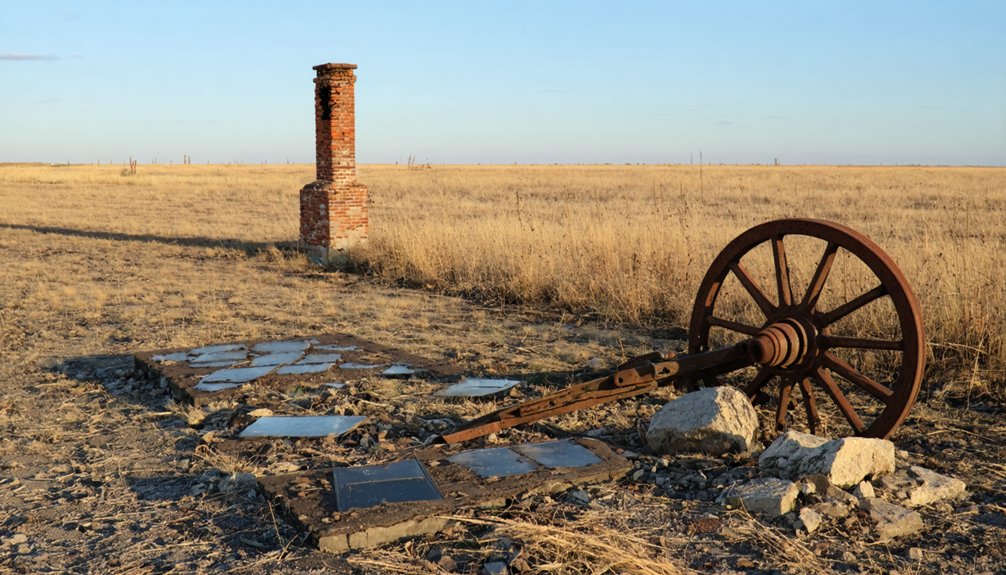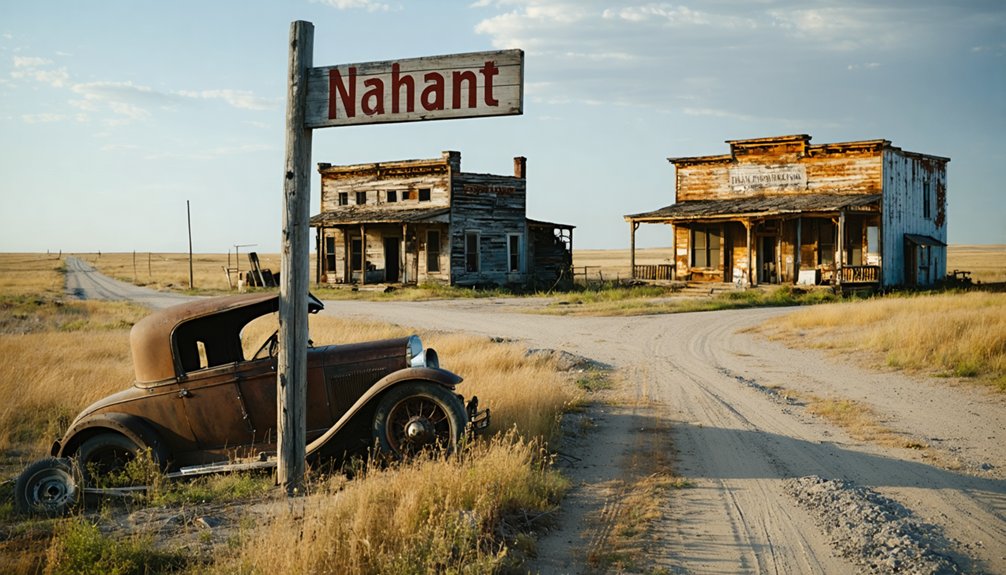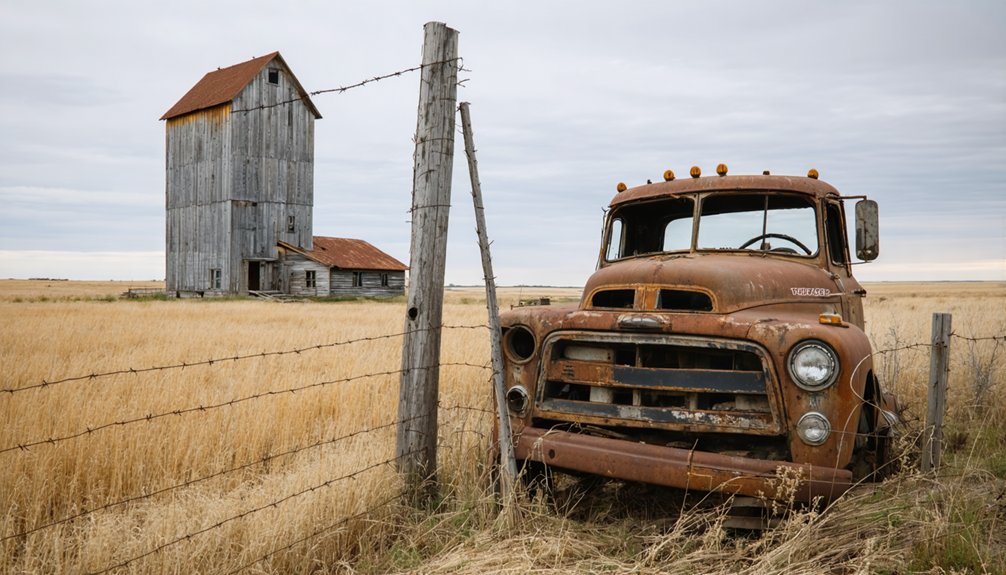You’ll find the ghost town of Nahant hidden in South Dakota’s Black Hills, where 500 residents once enjoyed a thriving lumber and mining community. In its 1900s heyday, the McLaughlin Tie and Timber Company built modern homes with electricity, telephones, and running water. While a devastating 1909 fire destroyed the $40,000 mill, you can still spot traces of this forgotten boomtown, including a single remaining residence and the relocated schoolhouse. The town’s untold stories lie beneath years of natural growth.
Key Takeaways
- Nahant was a thriving frontier town established in 1890, growing to 500 residents through logging, mining, and railway activities.
- The town featured modern amenities like electricity and running water, with company-built houses and essential services for its residents.
- McLaughlin Tie and Timber Company’s devastating mill fire in 1909 marked the beginning of the town’s decline.
- Today, only one original residence and a relocated school building remain as physical remnants of Nahant’s existence.
- The former townsite near Montana City has been reclaimed by nature, with no historical markers indicating its past significance.
The Birth of a Black Hills Boomtown
Three distinct forces converged in 1890 to birth the bustling town of Nahant in South Dakota’s Black Hills: logging, mining, and the railway. The discovery of gold in 1874 during Custer’s expedition had already transformed the region’s destiny.
You’d have witnessed the McLaughlin Tie and Timber Company’s logging techniques transforming the landscape while mining equipment rumbled at the Montana Mine. By 1902, when the Globe Mining Company arrived, Nahant was flourishing with possibilities and promise. Like its Massachusetts namesake that was originally part of Lynn, this South Dakota town emerged from humble beginnings.
The convergence of McLaughlin’s logging operations and Montana Mine’s machinery heralded a new era of industrial progress in Nahant.
The town quickly grew to 500 residents as the McLaughlin Company built your community from the ground up. They didn’t just create jobs – they built your homes, established your post office, and constructed your school.
When they extended the railway line to Moskee, Wyoming in 1906, you gained a crucial connection to the wider world, cementing Nahant’s place in the Black Hills’ dynamic frontier story.
Life in the Lumber Era
While mining initially drew settlers to Nahant, it was the McLaughlin Tie and Timber Company that truly shaped daily life in this Black Hills community after 1902.
You’d have found yourself among 500 residents living in company-built houses, connected by telephone lines to bustling logging camps. McLaughlin’s advanced logging techniques included a standard gauge railway network stretching to Moskee, Tinton, and Cold Springs, revolutionizing timber transport across the region. Like other lumber operations of the era, they maintained a strict cash-only sales policy. The company followed the example of early sawmills that first emerged in Custer to supply building materials.
Life wasn’t all work, though. You could’ve joined your neighbors at the clubhouse for basketball games or roller-skating, celebrating when the town team defeated Deadwood.
With a monthly payroll of $47,000, McLaughlin guaranteed steady employment while providing essential amenities like a post office, carpenter shop, and communal water tank that kept this lumber town thriving.
McLaughlin Tie and Timber Company’s Legacy
Despite its promising start, McLaughlin Tie and Timber Company’s legacy was forever altered by the devastating fire of April 1909. Workers typically produced 25 ties per day before the company’s decline, reflecting the intensive manual labor that characterized the timber industry. You can trace the timber industry’s impact through the rise and fall of this once-thriving enterprise, which exemplified the economic cycles common to Black Hills resource towns.
The McLaughlin Timber Company’s dramatic rise and sudden fall mirrors the boom-and-bust destiny of many Black Hills resource towns.
The company’s $49,000 monthly payroll had sustained a vibrant community of 500 residents, complete with modern amenities and a bustling social life.
- The fire’s $40,000 damage, only half-covered by insurance, proved insurmountable.
- Company operations bridged South Dakota and Wyoming through an innovative private railroad.
- Community infrastructure included electricity, phones, and a water system.
- Only one original house remains as evidence of this once-prosperous lumber town.
Daily Life and Community Spirit
Life in Nahant bustled with activity during its peak years, as the tight-knit community of 500 residents built a remarkable frontier town.
You’d find locals gathering at the vibrant clubhouse, where community gatherings centered around basketball games, roller skating sessions, and lively dances that brought everyone together.
Unlike many rough frontier settlements, you’d experience modern conveniences like electricity, telephones, and running water.
The painted frame buildings housed essential services, including a doctor’s office, post office, and school.
Social connections flourished at the hotel and general store, where travelers and townspeople mingled freely.
Despite its remote location, you’d witness a thriving community spirit that transformed this Black Hills town from a mere working settlement into a real home for its residents.
The town’s prosperity was largely driven by its dual focus on lumbering and mining operations.
The McLaughlin Tie and Timber Company provided steady employment with its impressive monthly payroll of $49,000.
Modern Amenities in a Frontier Town
In Nahant’s early years, you’d find a town working to balance frontier practicality with modest modern comforts through its basic but crucial infrastructure.
You could witness how the post office served as the community’s wider world connection, while the water tank and well system provided residents with reliable access to clean water. Much like Ardmore before it lost residents due to lack of drinking water, having a reliable water source was vital to keeping the community alive. Similar to other ghost towns like Scenic with its operational post office, these essential services remained active the longest.
The town’s commitment to progress showed in its essential services like the school and carpenter shop, though it never developed the more advanced amenities that larger Black Hills settlements enjoyed.
Early Electricity and Lighting
While many frontier settlements relied on oil lamps and candlelight, Nahant distinguished itself by embracing electric power in the early 1900s. You’d find electric lighting innovations throughout the town’s painted frame buildings, from the bustling clubhouse to residential homes. This modern advancement brought new safety measures and extended community activities well into the evening hours.
- Basketball games and roller-skating events lit up the clubhouse after dark
- Electric lights enhanced safety in the post office, school, and blacksmith shop
- Incandescent bulbs brightened homes, replacing traditional oil lamps
- Street lighting improved nighttime navigation and community security
The McLaughlin company’s substantial monthly payroll of nearly $49,000 helped fund these electrical improvements, transforming Nahant into a beacon of progress among frontier settlements.
The combination of electric safety features and modern amenities made the town an attractive place for workers and their families.
Progressive Communication Systems
Modern communication networks came to Nahant alongside its electrical advancements, setting the town apart from other frontier settlements. You’d have found cutting-edge wireless infrastructure throughout the community, featuring distributed antenna systems that guaranteed reliable coverage across the growing township.
The communication evolution in Nahant wasn’t just about keeping up with the times – it represented the town’s commitment to progress. Local leaders invested in low-voltage cabling systems and advanced radio technologies, connecting residents through a network that would’ve rivaled larger cities. Building structure impacts were carefully considered when implementing the town’s wireless systems.
Public safety remained a priority, with dedicated emergency communication systems installed to protect the community. The forward-thinking approach to telecommunications demonstrated Nahant’s determination to build a modern, well-connected society on the South Dakota frontier.
Town’s Entertainment Innovations
Despite its frontier location, Nahant stood out among South Dakota settlements with its remarkably progressive entertainment facilities. You would’ve found yourself at the center of vibrant community gatherings in the town’s innovative clubhouse, where recreational activities flourished beyond what you’d expect from a remote mining town.
This multi-purpose social center became the heartbeat of Nahant’s leisure life, offering entertainment options that rivaled more established cities.
- Dance events brought residents together for lively social connection
- Basketball games showcased athletic competition and team spirit
- Roller skating sessions provided year-round active entertainment
- Modern amenities like electricity enhanced these social experiences
The clubhouse transformed Nahant from a mere work camp into a thriving community where you could enjoy the finer aspects of modern social life.
The Great Fire of 1909

A devastating fire swept through Nahant in April 1909, destroying the McLaughlin Company’s $40,000 mill and sending flames so high they could be seen from Lead, fifteen miles away.
The fire dealt a crushing blow to the local logging industry, consuming five railroad cars, including three loaded with 975 ties, and a stripping shed packed with thousands more.
You’d have witnessed 90,000 board feet of lumber and six carloads of fresh logs reduced to ashes that day.
While the town’s homes kept their lights on and residents stayed safe, the McLaughlin Company never recovered from the disaster.
With insurance covering only half the losses and poor management decisions following the fire, this catastrophic event marked the beginning of Nahant’s decline – a stark reminder of the importance of fire prevention in timber towns.
Traces of the Past: What Remains Today
Today’s visitor to Nahant will find little evidence of the once-bustling logging town, with just a single residence standing as the last sentinel of its former glory.
Nature has steadily reclaimed the hilltop site near Montana City, with forests and pastures now covering the ghostly remnants of what was once a thriving Black Hills community. The great fire of 1909 claimed the main lumber mill, and time has erased nearly all other traces of the town’s industrial past.
Time and wilderness have slowly consumed Nahant, leaving only whispers of its bustling past beneath nature’s growing blanket.
- The old school building survives, though relocated to a nearby ranch
- Scattered foundations lie hidden beneath years of natural growth
- No historical markers guide visitors through Nahant’s vanished streets
- The solitary standing house serves as the only visible landmark of the former settlement
Getting to Nahant: Then and Now

While the physical remnants of Nahant have largely disappeared, the paths that once led to this vibrant logging community tell their own fascinating story.
In its heyday, you’d find Nahant connected by local roads and an impressive railroad network built by McLaughlin Tie and Timber Company, linking the town to Wyoming’s timber operations despite challenging 28-34% grades.
Today, you’ll need to embrace different access routes. The Mickelson Trail, built on former railroad grades, serves as your gateway to Nahant’s past.
You’ll want to secure a trail pass first, as the site sits on private property. While hiking challenges include traversing meadowland without standing structures, GPS coordinates (44.17665, -103.755475) will guide you to where this once-bustling logging town stood.
Economic Impact on Lawrence County
Despite its eventual decline, Nahant played a pivotal role in shaping Lawrence County’s economic landscape during the early 20th century through its mining operations.
While the town’s mining legacy left an indelible mark on the region’s development, you’ll find its influence extends well beyond the abandoned mine shafts.
Today, Lawrence County’s economic recovery draws strength from diverse sectors, including a robust $264.5 million agricultural industry and tourism centered around ghost towns like Nahant.
- Mining operations created essential infrastructure that still shapes regional transportation routes
- Local food initiatives and USDA-supported storage projects boost rural economic resilience
- Tourism and heritage sites generate hospitality revenue in nearby Lead and Deadwood
- Modern mining sector employs 195 people, building upon foundations laid by historic sites like Nahant
Preservation and Historical Documentation
The South Dakota State Historical Society leads dedicated efforts to preserve Nahant’s rich legacy, building upon the economic foundations that shaped Lawrence County.
Through historical preservation initiatives, you’ll find digitized photographs, archived documents, and oral histories that paint a vivid picture of this once-thriving community of 500 residents.
Modern documentation techniques, including GPS mapping and digital archives, help track what remains of Nahant’s past.
While you won’t find many physical structures today – just meadows where the McLaughlin sawmill once stood – the Society’s detailed records keep the town’s memory alive.
Although private land ownership limits access, you can explore Nahant’s history through Society membership, which grants you access to journals, maps, and research about this remarkable Black Hills ghost town.
Frequently Asked Questions
Were There Any Notable Crimes or Lawlessness Incidents in Nahant’s History?
You won’t find any documented crime reports or law enforcement incidents in historical records. The town’s strong company oversight and community amenities likely fostered an orderly environment during its brief existence.
What Native American Tribes Originally Inhabited the Area Around Nahant?
You’d find the area was primarily Dakota Sioux territory, with Western Dakota bands like the Yankton and Yanktonai maintaining their tribal culture through hunting, fishing, and gathering along local waterways.
What Was the Average Home Price in Nahant During Its Peak?
While you’d naturally be curious about historical economy indicators, I must share that no specific average home prices from Nahant’s peak period have survived in the records to inform us today.
Did Any Famous Historical Figures Ever Visit or Stay in Nahant?
You won’t find records of any famous visitors in this old mining town. While the Black Hills region attracted notable figures, historical significance came from the community’s industrial role, not celebrity connections.
What Natural Disasters, Besides the 1909 Fire, Affected the Town?
Like a relentless siege, nature’s fury battered your ancestors’ town through devastating tornadoes, bone-chilling blizzards, and merciless flooding. Drought’s dusty grip and flood damage repeatedly tested your community’s resilient spirit.
References
- https://kids.kiddle.co/Nahant
- https://freepages.history.rootsweb.com/~gtusa/usa/sd/blackhills.htm
- https://www.sdhspress.com/journal/south-dakota-history-2-2/some-black-hills-ghost-towns-and-their-origins/vol-02-no-2-some-black-hills-ghost-towns-and-their-origins.pdf
- https://blackhillsatvdestinations.com/nahant-ghost-town/
- https://www.sdpb.org/rural-life-and-history/2023-08-21/some-black-hills-ghost-towns-and-their-origins
- https://core.ac.uk/download/pdf/345016075.pdf
- https://en.wikipedia.org/wiki/List_of_ghost_towns_in_South_Dakota
- https://freepages.history.rootsweb.com/~gtusa/usa/sd.htm
- https://en.wikipedia.org/wiki/Nahant
- https://www.americanhistorycentral.com/entries/black-hills-gold-rush/



